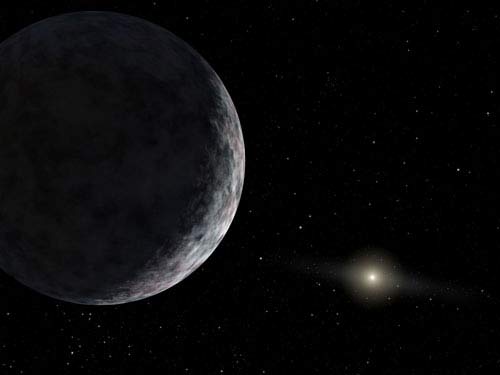Dwarf Planet Outweighs Pluto (original) (raw)

Artist's rendering of Eris, announced in July 2005 by Mike Brown of Caltech. It is more massive than Pluto. The sun is in the background. (Image credit: NASA/JPL/Caltech)
The dwarf planet that effectively forced astronomers to strip Pluto of its planethood is not only bigger than the former ninth planet, but also much more massive, a new study finds.
Michael Brown, a planetary scientist at Caltech, and his graduate student Emily Schaller have determined that Eris, discovered in 2005 by Brown and his team, is about 27 percent more massive than Pluto.
The finding, detailed in the June 15 issue of the journal Science, also confirms Eris and Pluto have similar compositions.
The moon holds the key
Eris circles the sun from about 9 billion miles away—about twice the distance of Pluto at the farthest point in its orbit. Its discovery was one of several factors that led some astronomers to create a new definition for planethood at the 2006 meeting of the International Astronomical Union (IAU) in Prague. The ruling reduced the planet count in our solar system to eight and left Pluto renamed as a "dwarf planet."
To determine Eris’ mass, the researchers used the Hubble Space Telescope and the Keck Observatory to calculate the orbital speed of its moon, Dysnomia. According to Newtonian physics, the more massive a celestial object is, the faster its satellite will zip around it.
“So by looking at the time it takes the moon to go around Eris, we’re able to calculate the mass,” Schaller said.
Breaking space news, the latest updates on rocket launches, skywatching events and more!
Because Eris and Dysomnia are located more than 90 times farther from the sun than Earth--out in the Kuiper Belt region of the solar system, they appear as little more than pricks of light in telescope observations. “Eris is slightly larger than a point source, but just barely,” Schaller said.
Dysnomia is thought to be less than 100 miles (150 km) across and to take about 16 Earth-days to make one trip around Eris.
Eris itself is believed to have a diameter of 1,490 to 1,860 miles (2,400 to 3,000 km). “To put that into perspective, if you took all the asteroids in the asteroid belt [between Mars and Jupiter] and multiplied by four, they would easily all fit into Eris,” Schaller told SPACE.com.
Pluto has a diameter of about 1,430 miles (2,300 km) across.
Knowing Eris’ mass and size, the researchers were also able to confirm that Eris’ density is similar to that of Pluto, and that it is therefore likely made up mainly of rock and water ice.
Born into controversy
Formerly known as 2003 UB313, the dwarf planet was rechristened Eris (pronounced ee’-ris) by astronomers last year. The name is fitting: Eris is the Greek goddess of discord and strife, who stirred up jealousy and envy among the goddesses that led to the Trojan War. When Eris the dwarf planet was discovered, it created a furor among astronomers that led to the controversial decision last year to demote Pluto.
While some planetary scientists still oppose the decision on grounds that the new definition of planet is not specific enough, Schaller thinks the IAU made the right choice. “I think that really only the big eight planets distinguish themselves as clearly different from all the other objects,” Schaller said.
Schaller points to the example of Ceres, a former asteroid whose naming history resembles that of Pluto. When Ceres was first discovered in 1801, it was classified as a planet on account of its large size (it is 530 miles across). But “once they started discovering more and more asteroids, it got a bit ridiculous,” Schaller said.
As with Pluto, Ceres was downgraded to the status of asteroid once scientists realized it was just the first-known of a class of rocky bodies residing mainly between the orbits of Mars and Jupiter. Last year, the IAU voted to reclassify Ceres as a dwarf planet, elevating it to the same ranks as Pluto and Eris.
In the current debate surrounding Pluto, Schaller sees history repeating itself. “Pluto was discovered and for a really long time there wasn’t anything else discovered,” she said. “But if it had transpired in the same way to the asteroid belt where the following year many more objects were discovered, then I think we wouldn’t be having this discussion right now.”
- Video: Planet Hunter
- Image Gallery: The New Solar System
- Reaching for the Edge: New Horizons Spacecraft Bound for Pluto
Join our Space Forums to keep talking space on the latest missions, night sky and more! And if you have a news tip, correction or comment, let us know at: community@space.com.
Ker Than is a science writer and children's book author who joined Space.com as a Staff Writer from 2005 to 2007. Ker covered astronomy and human spaceflight while at Space.com, including space shuttle launches, and has authored three science books for kids about earthquakes, stars and black holes. Ker's work has also appeared in National Geographic, Nature News, New Scientist and Sky & Telescope, among others. He earned a bachelor's degree in biology from UC Irvine and a master's degree in science journalism from New York University. Ker is currently the Director of Science Communications at Stanford University.